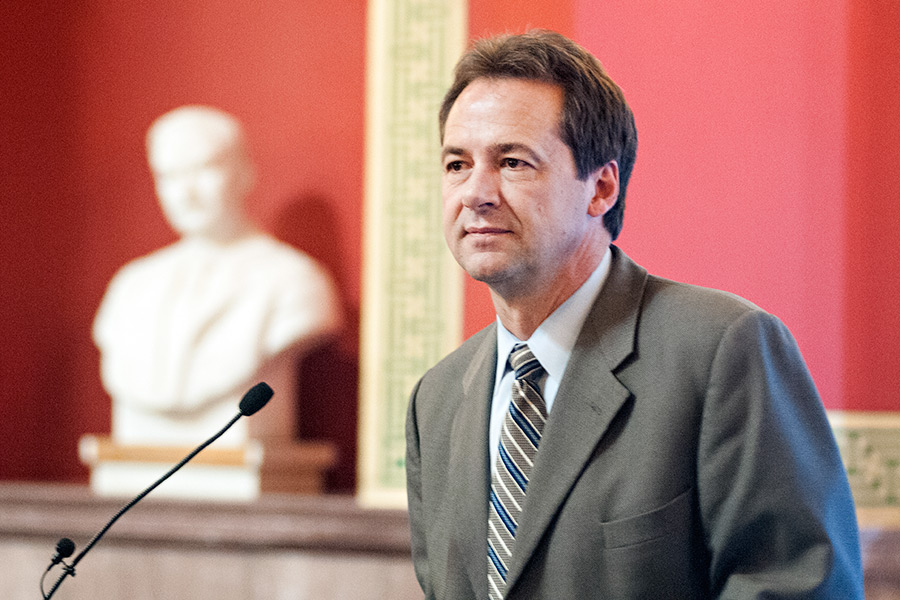Unless a remedy is found for the state’s looming budget crisis, Montana residents can expect devastating losses to essential services across the board, and Democratic Gov. Steve Bullock says any solutions will require more than his efforts alone.
“I need a willing dance partner,” he said in an interview on Friday. “If we don’t figure out a way to generate some additional revenue, these cuts are going to fall on the backs of Montanans. And it is going to hurt. You can’t just cut your way through this by getting rid of state employees.”
To be clear, there will be cuts even with short-term solutions.
But Bullock said he has identified new revenue streams that could salvage services and programs that would otherwise end up on the chopping block.
And yet so far his calls for a special session to address the state’s budget revenue shortfalls have been rebuffed by Republican state lawmakers, many of whom remain unwilling to consider additional revenue streams in the form of tax increases to backfill a $227 million budget shortfall on the heels of a disastrous wildfire season and overly optimistic revenue projections. Although the state’s economy is strong, the revenue that funds state government was projected to be higher than it is, due in part to slumping market prices for oil, coal and agriculture.
Coupled with the most expensive wildfire season in state history, and Montana is in a pinch.
“My job is to manage the budget in good times and in bad,” Bullock said. “But I didn’t sign up to hurt people, which is what these cuts are going to do unless we work together and figure something out.”
Bullock’s proposed solutions include increasing the state tax on cigarettes, wine and medical marijuana; an increase to the state’s bed tax; and creating a new tax bracket for those with taxable incomes topping $500,000 a year to promote tax equity.
“It doesn’t make sense that someone making the minimum wage is subject to the same tax rate as someone making a half-million dollars a year,” he said.
Those changes to Montana’s tax laws alone would bring in millions of dollars in new revenue, he said.
But Republicans have flatly rejected the governor’s “tax fairness” proposals, calling it “class warfare” that unfairly punishes wealthy job creators.
Most recently, Bullock asked state agencies to cut their budgets by 10 percent following recommendations from the Office of Budget and Program Planning in an effort to reduce state spending by $229.3 million. It’s the maximum amount of money the governor can ask state agencies to trim from their budgets for the biennium under state law.
The governor is waiting on the Legislative Finance Committee to make a recommendation for cuts within government agencies, which he expects to receive by Oct. 4. After he receives the specific recommendations, Bullock said there is no statutory timeline for making a decision.
In order to maintain a legally balanced budget in 2019, an ending-fund balance, or “rainy day fund,” must amount to $143 million, regardless of how the money stacks up.
Those figures and dollar signs might seem a bit obscure in the context of a general fund budget of $2.1 billion a year, he said, but if residents consider the blow that every dollar lost will deal to essential services like education, child protection, hospice, mental health, public safety, and more, the dire scenario grows more visceral.
The hardest-hit agency under the 10 percent reduction plan is the state Department of Public Health and Human Services. Bullock asked the department to find ways to trim $105 million in spending over the next two years, including in senior and long-term care, child protection services and addictive and mental disorder programs.
Montana has already exhausted its wildfire suppression reserve account and other emergency funds, and tax collections are below the estimates set in the state budget, adding to the financial strain.
The state has spent more than $60 million on fire suppression since June — not counting the U.S. government costs to respond to fires on federal lands — and the blazes continue to drive up those costs.
The state university system must identify another $44 million in spending reductions, which will almost certainly drive up tuition costs. State lawmakers already slashed the Office of the Commissioner of Higher Education’s budget in the 2018-2019 state budget passed in April.
“When you are cutting that deep, there’s no way around losing essential services at every branch,” Bullock said. “These aren’t scare tactics — this is the reality of having a legal budget.”
With the state stuck between a rock and a hard place, Bullock said the least-desirable outcome would be to simply implement the cuts, an outcome that would impact Montana residents this fall.
“The more responsible thing to do is to make cuts in some areas, but work to mitigate the impact to vulnerable Montanans,” he said. “But the Legislature needs to step up and say, ‘We created this, let’s find a way out.’ Montana has to decide whether these are the cuts we want, or do we want more moderate cuts by reducing some services while increasing revenues to soften the blow.”
To learn more about the budget shortfall, and what 10 percent reductions would mean to each agency, visit www.balancedbudget.mt.gov.
